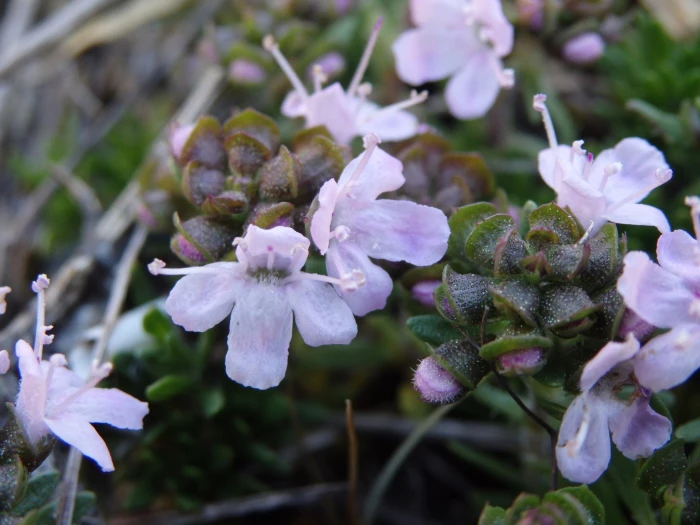Cretan Thyme
(Thymus caespititius)
Cretan Thyme (Thymus caespititius)
/
/

Carminda Santos
CC BY 4.0
Image By:
Carminda Santos
Recorded By:
Copyright:
CC BY 4.0
Copyright Notice:
Photo by: Carminda Santos | License Type: CC BY 4.0 | License URL: http://creativecommons.org/licenses/by/4.0/ | Rights Holder: Carminda Santos | Publisher: iNaturalist | Date Created: 2021-05-20T16:17:03-07:00 |














Estimated Native Range
Climate Requirements
| • Precipitation | 50" - 60" |
| • High Temp. | 73°F - 79°F |
| • Low Temp. | 39°F - 53°F |
Summary
Thymus caespititius, commonly known as Cretan Thyme, is an evergreen shrub native to rocky slopes and scrubland of the Iberian Peninsula and the Azores. This plant is a dwarf, aromatic, mat-forming groundcover shrub that typically grows to a height of 2-3 inches (5-8 cm) and spreads 6-12 inches (15-30 cm) wide. The narrow, spatula-shaped, smooth leaves are up to 6 mm (0.24 in) long, fringed with tiny hairs, and exude a pleasant fragrance when crushed. From late spring to summer, Cretan Thyme produces a profusion of rose, lilac, or white flowers in small, flattened heads that hug the mat of foliage, adding ornamental value to the garden.
Cretan Thyme is valued for its drought tolerance, aromatic foliage, and attractive flowers which are highly appealing to bees and butterflies. It is commonly used in rock gardens, as a ground cover, and in herb gardens for culinary purposes. Its low water requirements and adaptability to well-drained soils make it a suitable choice for xeriscaping. The cultivar Thymus caespititius ’Aureus’ is notable for its narrow, light gold leaves, adding a splash of color even when the plant is not in bloom. While it thrives in full sun, it can also tolerate light shade. It is hardy down to USDA Zone 7, but in colder climates, it should be protected from winter wetness to prevent root rot.CC BY-SA 4.0
Cretan Thyme is valued for its drought tolerance, aromatic foliage, and attractive flowers which are highly appealing to bees and butterflies. It is commonly used in rock gardens, as a ground cover, and in herb gardens for culinary purposes. Its low water requirements and adaptability to well-drained soils make it a suitable choice for xeriscaping. The cultivar Thymus caespititius ’Aureus’ is notable for its narrow, light gold leaves, adding a splash of color even when the plant is not in bloom. While it thrives in full sun, it can also tolerate light shade. It is hardy down to USDA Zone 7, but in colder climates, it should be protected from winter wetness to prevent root rot.CC BY-SA 4.0
Plant Description
- Plant Type: Shrub
- Height: 0.8-1 feet
- Width: 0.8-1 feet
- Growth Rate: Moderate
- Flower Color: Pink, White, Purple
- Flowering Season: Spring, Summer
- Leaf Retention: Evergreen
Growth Requirements
- Sun: Full Sun
- Water: Low, Medium
- Drainage: Medium, Fast
Common Uses
Bee Garden, Bird Garden, Butterfly Garden, Deer Resistant, Drought Tolerant, Groundcover, Low Maintenance, Rabbit Resistant, Showy Flowers
Natural Habitat
Native to rocky slopes and scrubland of the Iberian Peninsula and the Azores
Other Names
Common Names: Azores Thyme, Kryptimjan
Scientific Names: Thymus caespititius, Thymus micans, Thymus caespititius var. macranthus, Thymus caespititius var. albicans, Thymus azoricus, Origanum caespititium
GBIF Accepted Name: Thymus caespititius Brot.